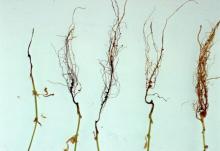See:
Pea (Pisum sativum) - Aphanomyces Root Rot
Cause Several fungi or fungus-like microorganisms including Fusarium solani f. sp. pisi, Thielaviopsis basicola, Phoma medicaginis var. pinodella, and Pythium spp. Each survives in soil a long time and produces resistant survival structures. F. solani f. sp. pisi is favored by lighter soils and soil temperatures above 75°F.
Research in Oregon and Washington indicates any factor that stresses the plant and reduces root growth increases this disease. Such factors as compaction, poor fertility, and herbicide damage can dramatically increase disease severity.
Symptoms Infected plants are stunted, and lower leaves yellow dramatically. Gray, reddish, or black lesions are on the lower stem and roots. Often the taproot is so badly rotted only decayed shreds are left.
Cultural control
- Do not plant peas or similar hosts in the same soil more than once every 5 years.
- Avoid soil compaction, which favors the disease. Avoid working the ground, planting, or applying herbicides in spring when soil is too wet. Reduce tillage operations, till in fall rather than spring, and use caterpillar-type tractors if spring tilling is necessary.
- If practical, seed in spring when soil is below 65°F.
- Plant seed with good vigor as indicated by germination, vigor, and electro-conductivity tests.
- If advised to apply nitrogen fertilizer, apply moderately.
Chemical control Only if Pythium spp. are a problem.
- Allegiance-FL (Group 4) at 0.75 fl oz/100 lb seed plus a dye. See label for reentry restrictions.
- Ridomil Gold SL (Group 4) may be banded or surface applied at 0.5 to 1 pint/A. Incorporate 2-inches deep when used. 48-hr reentry.
Biological control Efficacy in the Pacific Northwest is unknown.
- Bexfond at 7 to 14 fl oz/A. 4-hr reentry. O
- Stargus at 6 to 8 fl oz per 1,000 ft row as an in-furrow treatment. Preharvest interval is 0 days. 4-hr reentry. O



